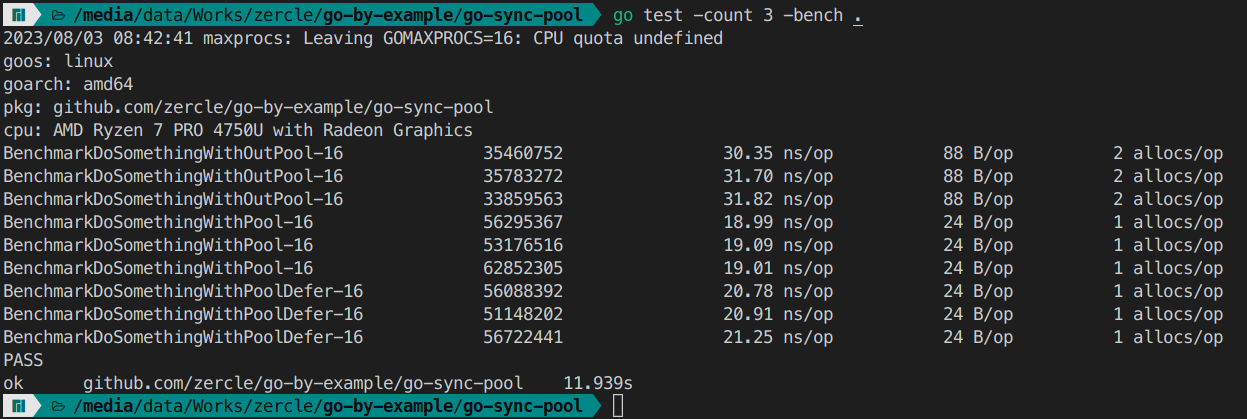Go กับการ re-use memory ด้วย sync.Pool

ถ้าใครเขียน goroutine ก็คงจะเคยพบเจอกับ sync.WaitGroup ที่ใช้ในการทำ wait group ให้ goroutine กันแล้ว แต่ใน pkg sync มี type นึงที่มีประโยชน์ในงานที่อยากจะมาแนะนำ คือ sync.Pool ที่จะมาช่วย re-use memory ลดการ allocate ที่ต้องใช้ของเดิมซ้ำ ๆ ได้
การทำงานของ sync.Pool
มาดูการทำงานของ sync.Pool{} ว่าทำงานยังไง โดย pool จะมี 2 ตะกร้าคือ Pool และ Victim สำหรับ cache ก่อนจะโดน garbage collector (GC) เคลียร์ออกไป
basic
เริ่มต้น จากไม่มีอะไรเลย
| Operation | Pool | Victim | caller | |
|---|---|---|---|---|
| 0 | 0 |
get จาก Pool เปล่า จะเป็นการ allocate ให้ใหม่
| Operation | Pool | Victim | caller | |
|---|---|---|---|---|
| get | 0 | 0 | allocate | 1 |
จากนั้นก็ put กลับคืน Pool
| Operation | Pool | Victim | caller | |
|---|---|---|---|---|
| put | 1 | 0 | ← | 0 |
คนที่ใช้ต่อก็จะ get จาก Pool ที่มีอยู่แล้ว
| Operation | Pool | Victim | caller | |
|---|---|---|---|---|
| get | 0 | 0 | → | 1 |
garbage collector
ก่อน garbage collector ทุกอย่างอยู่ใน Pool
| Operation | Pool | Victim | caller | |
|---|---|---|---|---|
| 3 | 0 |
หลังจาก garbage collector จะโดนย้ายไปพักที่ Victim
| Operation | Pool | Victim | caller | |
|---|---|---|---|---|
| GC | 0 | 3 |
ถ้ามี get หลังจากจาก garbage collector ก็จะเอาจาก Victim ไปใช้
| Operation | Pool | Victim | caller | |
|---|---|---|---|---|
| get | 0 | 2 | → | 1 |
ตอนที่ put กลับคืน Pool
| Operation | Pool | Victim | caller | |
|---|---|---|---|---|
| put | 1 | 2 | ← | 0 |
หลังจาก garbage collector อีกรอบ ที่ค้างใน Victim ก็จะโดนล้างออกไป ส่วนที่อยู่ใน Pool ก็จะมารอใน Victim แบบนี้วนไปเรื่อย ๆ
| Operation | Pool | Victim | caller | |
|---|---|---|---|---|
| GC | 0 | 1 |
หน้าตาของ sync.Pool
ตัวอย่างดัดแปลงจาก sync example-Pool โดย DoSomethingWithOutPool เป็นท่าดั้งเดิมแบบไม่ใช้ pool DoSomethingWithPool ใช้ pool โดยการ put กลับเข้า pool หลังจากใช้งานเสร็จ DoSomethingWithPoolDefer ใช้ pool โดยการ defer put กลับเข้า pool หลังจากจบ function
var bufPool = sync.Pool{
New: func() any {
// The Pool's New function should generally only return pointer
// types, since a pointer can be put into the return interface
// value without an allocation:
return new(bytes.Buffer)
},
}
// timeNow is a fake version of time.Now for tests.
func timeNow() time.Time {
return time.Unix(1690909200, 0)
}
func DoSomethingWithOutPool() {
buff := new(bytes.Buffer)
// write to buffer
buff.WriteString(timeNow().UTC().Format(time.RFC3339))
// discard for test
io.Discard.Write(buff.Bytes())
// clear buffer before return
buff.Reset()
}
func DoSomethingWithPool() {
buff := bufPool.Get().(*bytes.Buffer)
// write to buffer
buff.WriteString(timeNow().UTC().Format(time.RFC3339))
// write from buffer to discard for test
io.Discard.Write(buff.Bytes())
// clear buffer before return to pool
buff.Reset()
bufPool.Put(buff)
}
func DoSomethingWithPoolDefer() {
buff := bufPool.Get().(*bytes.Buffer)
// clear buffer before return to pool after the end of function
defer func() {
buff.Reset()
bufPool.Put(buff)
}()
// write to buffer
buff.WriteString(timeNow().UTC().Format(time.RFC3339))
// write from buffer to discard for test
io.Discard.Write(buff.Bytes())
}
เปรียบเทียบผลงาน ผ่านการใช้ (*testing.B).RunParallel เพื่อทดสอบแบบเป็น Parallel
ข้อดี
- concurrent safe ทำให้สามารถใช้งานใน goroutine ได้แบบพร้อม ๆ กัน
- ประหยัดการ allocate memory จากการยืม cache ใน pool มาใช้
ข้อควรระวัง
- ข้อมูลใน pool หายไปตามรอบของ GC (ไม่ได้อยู่ตลอดไปนะ)
- ถ้าไม่
putกลับคืน pool จะทำให้ทุกครั้งที่เราgetจะเป็นการสร้าง instance ใหม่ไปเรื่อย ๆ ทำให้ระบบโดยรวมสิ้นเปลืองมากขึ้น (เพราะต้องไป allocate heap เพิ่มขึ้นเรื่อย ๆ ) ทางสายกลางก็สามารถใช้defer putทันทีไว้หลังจากgetช่วยให้ไม่ลืมputกลับคืน pool ได้
แล้วควรใช้ sync.Pool{} ตอนไหนดี
- ตามปกติของ pkg sync เลย นั้นก็คือใช้ใน goroutine ที่มีการใช้งาน method เดิม ๆ ซ้ำ ๆ จะได้ไม่ต้องเปลือง allocate memory ทุกครั้งที่วนรอบการทำงาน
- ใช้กับงานที่มีค่าใช้จ่ายในการ initialize เยอะ และใช้ซ้ำบ่อย ๆ เช่น
parserreaderwriterbuffernetwork connectionฯลฯ (ประมาณว่าค่าปั้นตัวมันแพง ขอยืมมาใช้งานละกัน จบงานก็ส่งคืน อะไรแบบนี้)- ตัวอย่าง เช่น ParserPool ของ valyala/fastjson